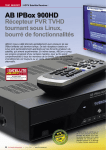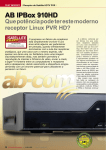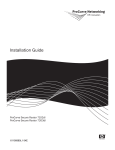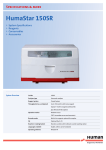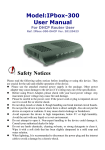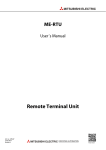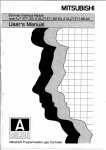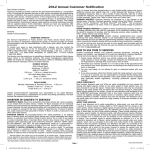Download ab IPBox 9000HD User manual
Transcript
TEST REPORT HDTV Satellite Receiver AB IPBox 900HD Promising feature-loaded multisystem Linux-based HDTV PVR receiver ABCom has already positively surprised us with several brilliant IPBoxes recently. Such Linux-based receivers are especially valued by the satellite enthusiasts, who love to experiment. At the same time, ABCom designed its own firmware in a way, that it would be understandable to all family members. Hardcore DXers always had a rich variety of alternative firmware variants to choose from. Man agin g re c ord ing 12-01/2009 AB IPBOX 900HD Perfect HD receiver both for a family as for the satellite enthusiast 0.61 50 TELE-satellite & Broadband — 12-01/2009 — www.TELE-satellite.com But time doesn’t stand still, more and more attention is attracted by HDTV nowadays. Number of living rooms, where the prime position is taken by a plasma or LCD TV-set, is grow- s Pl a yin gM P 3s f ro ma US B don gl e i n g dramatically. Of course, HDTV receivers also started to appear, but most of the early ones left the satellite enthusiasts unsatisfied. It took quite a while, before really powerful HDTV boxes could hit the market. TELE-satellite World www.TELE-satellite.com/... Download this report in other languages from the Internet: Arabic Indonesian Bulgarian Czech German English Spanish Farsi French Greek Croatian Italian Hungarian Mandarin Dutch Polish Portuguese Romanian Russian Swedish Turkish ﺍﻟﻌﺮﺑﻴﺔ Indonesia Български Česky Deutsch English Español ﻓﺎﺭﺳﻲ Français Ελληνικά Hrvatski Italiano Magyar 中文 Nederlands Polski Português Românesc Русский Svenska Türkçe www.TELE-satellite.com/TELE-satellite-0901/ara/abcom.pdf www.TELE-satellite.com/TELE-satellite-0901/bid/abcom.pdf www.TELE-satellite.com/TELE-satellite-0901/bul/abcom.pdf www.TELE-satellite.com/TELE-satellite-0901/ces/abcom.pdf www.TELE-satellite.com/TELE-satellite-0901/deu/abcom.pdf www.TELE-satellite.com/TELE-satellite-0901/eng/abcom.pdf www.TELE-satellite.com/TELE-satellite-0901/esp/abcom.pdf www.TELE-satellite.com/TELE-satellite-0901/far/abcom.pdf www.TELE-satellite.com/TELE-satellite-0901/fra/abcom.pdf www.TELE-satellite.com/TELE-satellite-0901/hel/abcom.pdf www.TELE-satellite.com/TELE-satellite-0901/hrv/abcom.pdf www.TELE-satellite.com/TELE-satellite-0901/ita/abcom.pdf www.TELE-satellite.com/TELE-satellite-0901/mag/abcom.pdf www.TELE-satellite.com/TELE-satellite-0901/man/abcom.pdf www.TELE-satellite.com/TELE-satellite-0901/ned/abcom.pdf www.TELE-satellite.com/TELE-satellite-0901/pol/abcom.pdf www.TELE-satellite.com/TELE-satellite-0901/por/abcom.pdf www.TELE-satellite.com/TELE-satellite-0901/rom/abcom.pdf www.TELE-satellite.com/TELE-satellite-0901/rus/abcom.pdf www.TELE-satellite.com/TELE-satellite-0901/sve/abcom.pdf www.TELE-satellite.com/TELE-satellite-0901/tur/abcom.pdf Available online starting from 28 November 2008 However, ABCom, which has a major experience in manufacturing Linux-based receivers, succeeded to go even further. What about a box, that could handle it all? Both HDTV and SDTV, in DVB-S and DVB-S2. With a possibility to quickly replace the satellite tuner and make it receive cable and terrestrial transmissions. With a user-friendly PVR, network connection and all other goodies that the penguin used to bring to the Linux-based receiver owners? This was the idea behind the two “brothers” - IPBox 9000HD, that we presented in one of the previous issues of TELE-satellite, and 900HD, which gets a closer look in this article. The “ yo un g e r ” we as brother, first thought, would be less impressive, then 9000HD. This started to prove wrong already from the moment we opened the box, delivered to our test lab. It looks much more compact, then 9000HD, but is also stylishly designed, and features an easy-to-read matrix VFD display in the middle of the front panel. With a help of seven buttons, located right under it, you access the menu, change channels, confirm selections, adjust the volume, all basic functions are perfectly covered, should something go wrong with the remote control. The bottom left corner contains the standby button, while the right one - a magnet-held flap, which covers two CI slots, providing access to encrypted transmissions. The rear panel is simply loaded with connec- www.TELE-satellite.com — 12-01/2009 — TELE-satellite & Broadband 51 part, we got here an E-SATA port, and even a 5V output to supply your external HDD with power. Now that’s what we call “caring about the user” ! Firmware update over the Internet Main Menu Satellite Configuration We had contradicting impressions about the remote control at first. Yes, it’s also packed with buttons, but some of them are located in places, where you wouldn’t expect them to be at first. But once actual tests started, we could get used to it amazingly fast. Actually, it was so logic to locate the “Menu” and “Next” buttons to the left and right side of the cursor keys respectively! Already after initial setup, your finger would intuitively search for them there, raising a question, why hardly anybody ever thought to organize the buttons so logically before. Each part of the remote control has buttons grouped for a special purpose - either for the PVR controlling, for the channel list organizing, for accessing the multimedia features etc. But the good part from the previous ABBoxes’ remote control remained - you can easily program it to control also your TV-set. Quite a large list with various TV models can be found on the last 11 pages of the user manual. Which, in its turn, also deserves some good words. Every single menu item of the official firmware is explained in details. With a step-by-step installation guide, you won’t get lost, even if it’s the first receiver you’re ever installing. Several connection variants are also clearly explained, and, in case you ordered a terrestrial or a cable tuner as well, full channel versus frequency charts are included, so you won’t have to google around for this information. Initial Setup DVB-S2 Manual Channel Search tors. Let’s start with the main power switch. Since the box we got for testing was equipped with DVB-S/S2 tuner, there is an IF input and the loop-through output, USB, RS-232 and Ethernet ports, one Scart-connector, three RCA jacks for video and audio output, another three - for YUV video output. Since we are talking about a HDTV receiver, HDMI socket couldn’t have been left out. S/PDIF output is also useful, if you pay extra attention to the audio quality. As for the PVR 52 TELE-satellite & Broadband — 12-01/2009 — www.TELE-satellite.com Once the mains plug of IPBox 900HD gets into the electricity socket in your home for the very first time, you’ll land in an installation wizard, which will first try to clear the language issue, offering you to select preferred languages for the on- screen menu, audio, subtitles and teletext. There is a lot to choose from - English, Russian, French, Italian, Dutch, German, Danish, Slovak, Czech, Hungarian, Norwegian, Polish, Portuguese, Spanish, Swedish, Greek, Turkish, Korean, Croatian, Bosnian and Serbian. Second step lets you set up the current date and time, and choose whether you’d like to have it automatically set in the future. Third screen finally gets you closer to channel reception, in case of a satellite tuner, this is the place where you have to enter the parameters of your system and program the satellites you plan to receive. Even an advanced system should be no problem, since all DiSEqC versions, 1.0, 1.1, 1.2 and 1.3 (USALS) are supported. LOF can be freely changed for every satellite, so even an exotic LNB would work perfectly. Once all the basic satellite data is stored, press the yellow button to proceed to the Channel Search menu. Here you have the two expected options - Manual or Automatic search. The latter just asks you, whether you’d like to have only FTA, only Crypt channels, or both, and if a network search would make you more happy, by filling the list with as many channels as possible. That’s all it takes here, just click “Search” and have a cup of coffee. Or not? Since ASTRA 19.2E position was fully scanned in 5 minutes, resulting in 1092 TV and 217 Radio channels. So if you just can’t wait to get that picture on the screen, you’d better stick around! In case of the manual search, you’ve got all the options you need for locking to DVB-S and DVB-S2 transponders, with modulation (QPSK or 8PSK) and special FEC variants for the latter. Entering PID codes is possible in a special menu, and IPBox 900HD has no problem with SCPC reception, Calabria Channel from HELLAS SAT 2 at 39.0E with SR of just 1425, was locked in a flash! The on-screen menu is logically organized, you can find any needed option in a couple of sec- onds. For example, the AV settings screen, where you can select the aspect ratio, TV system (SD-PAL, SD-NTSC, 720p-50 Hz, 720p-60 Hz, 1080i-50 Hz or 1080i-60 Hz), as well as the parameters of the Dolby Digital audio. Automatic Search HDD Setup Information screen with recording in progress Installation of the AB Boxes that we know wouldn’t be complete without connecting it to your home network, or directly to Internet. In case you have a router, just connect the IPBox 900HD to it with an Ethernet cable, and you’re set. DHCP should take care about all the IP address setting hassle etc, but if for whatever reason it doesn’t work, all the parameters can be set up manually. If you’re connecting directly to the Internet, ADSL user information take just seconds to be entered. At the moment it can mainly be used for the convenient software upgrade from www.abipbox.com. IPBox 900HD automatically logs in to the FTP server, offering you several firmware versions to choose from. You can forget about all the trouble getting the latest software to your receiver via RS-232 or USB port, the needed files downloaded and installed earlier then you can realise it. And this makes sense, for example, in the latest firmware version, ABCom added the support of FAT32 file system for the MP3 files and images you have on your USB dongle, so an endless search for nfs/ext formatting and access utilities for your Windows-based PC is a nightmare to forget. The hard disk for recording transmissions still has to be formatted in ext, but this is something IPBox 900HD can perfectly take care of. 54 TELE-satellite & Broadband — 12-01/2009 — www.TELE-satellite.com Everyday Use Once the channel search is completed, IPBox 900HD attempts to get the picture from the last channel it succeeded to store. Should it be unavailable for whatever reason, just press “OK” button to access a perfectly thought through channel list. It might seem a bit minimalistic at first, but try clicking around, and you’ll discover that it’s quite feature-loaded. Pressing the red button once or several times lets you sort the channel list in different ways by alphabet, by package, by satellite, by provider, FTA/encrypted. FAV button toggles between the main list and favorite list display, by default there are five - Sports, Drama, News, Movie and Music, but you can create as many new ones as you wish. However, to add channels to them, a special menu should be called, where the main list and the favorite group appear at the same time, so it’s not enough just to mark the needed channels in the main list. Returning to the channel list itself, pressing an “i” button allows you to delete, hide, lock, rename or move the selected channel, and, what we especially liked, adjust it’s default audio volume. It can be so annoying, when zapping around you endlessly have to adjust the volume on your TV-set or the receiver, because the providers didn’t care to make it perfectly equal. With IPBox 900HD it’s a one-time work to program it, and you would never have to worry about it again. Talking about zapping, it might not be surprisingly fast, but still, channel changing time will not get disturbing. It ranges from 0.5 up to 1.5 seconds, depending the chan- EPG in List mode EPG - program details EPG in Program Guide mode nel pair considered. It’s longer to go from one HDTV channel to another, located on a different transponder, and almost hardly noticeable between SDTV ones within the same transponder. Once the channel is chosen and IPBox 900HD locks to it, you can enjoy the perfect picture and sound, provided by this receiver. But when the broadcaster goes for a commercial break, you can play around a bit. Pay some attention to the buttons in the third top row of the remote control. Pressing the right one allows you to select another channel from the same transponder, and its live picture appears in a small window in the bottom right part of the screen. Two pictures can be made equally big by the leftmost button, the second left button can move the smaller picture around the screen, and with a second right button you can switch channels - the “subchannel” becomes the main one, one more click - and it goes viseversa. To exit the PiP mode, press the leftmost button again. It’s worth noticing, that besides watching two channels from one transponder in such a way, the third one can simultaneously be recorded. PVR would also hardly disappoint you. You think there is just one “Record” button and that’s it? No way. Besides the most obvious path, you can select the programs to be recorded in the EPG, by manually entering the start/stop time, or you can pre-set the time shift buffer, first watch the show, and then decide, if you want its recording stored. Timeshifting can also be helpful if, for example, you receive an important phone call, but don’t want to miss some exciting moments in the football match you’ve been watching. Just “pause” it, and once you’ve done talking, your favorite football players wait for you right where you left them. As for the other recordings, you can quickly access them, by just pressing the “Envelope” button on the remote control EPG is available in two variants - the simplified “list” mode, and in the full “program guide” mode. Click “EPG” once or twice for each of them respectively. Make sure you’ve set the correct time in the Local Time Settings menu, and you can easily check what’s on tonight, or what your favorite movie channel is going to show on Saturday evening. The “list” mode actually lists the upcoming events for the selected channel, with a possibility to get extended information about each of them, by pressing the “i” button. The “program guide” mode shows neighbouring channels as well, you can easily navigate between the programs, channels and days of the week, and even search for the program you’re interested in, by actually typing in its name. Pretty convinient, isn’t it? But, although, cyrillic and other special characters are perfectly displayed, the search function is restricted to latin only, which is somehow understandable. As for the multimedia features that we’ve already mentioned, there are two special buttons on the remote control, clearly reading “Music” and “Photo”. They provide quick and direct access to your media files, stored on a USB dongle, hard disk or at a specified network loca- www.TELE-satellite.com — 12-01/2009 — TELE-satellite & Broadband 55 + Expert Opinion Promising feature-loaded Linux-based receiver for HDTV and SDTV, supporting satellite, cable and terrestrial reception, depending on the installed tuner. Satellite tuner that we’ve tested is quite sensiNickolas tive. Ovsyadovskiy TELE-satellite No family member should have problems with Test Center operating it. Hungary Logically designed remote control. Support of FAT32 for the USB dongles. Built-in power supply for external hard disks. Adjusting an average channel audio volume in the channel list. Extended searching possibilities in the EPG. User-friendly PVR with timeshift. tion. MP3 player might look simple, but it perfectly does its job. And, as also already mentioned, the latest version of firmware supports FAT32 for the USB sticks, so you no longer have to worry about formatting it in a less popular file system. Upgrading the firmware to the most actual version also helped curing some hangs that we’ve experienced during the early stages of our tests. It clearly shows, that ABCom is busy working on improving it. But, the beauty of the whole thing is that it’s a Linux-based receiver! Alternative firmware is already starting to appear including even the legendary Enigma. A video of a first Enigma HD test version can be seen at their website www.abipbox.com. So although it’s more a family receiver at the moment, we can already expect its full potential to be uncovered soon. - 900HD, compared with its “older brother”, 9000HD, can have only one tuner at a time installed, but for a regular home usage this shouldn’t be a big problem. However, it still would have been nice to leave a possibility to install the HDD “internally”, so users upgrading from IPBox 250S or 350S could just move their HDD with recordings into the new 900HD, and get immediate access to them. Minor issue, which can hopefully be fixed in one of the coming versions - 900HD doesn’t detect the DRE-crypt CI module, which is widely used in some East European countries. Adjusting the channels’ volume in the list TECHNIC DATA ManufacturerABCom s.r.o., Gogolova 1, 95501 Topolcany, Slovakia Tel +421-38-5362-611 Fax+421-38-5322-027 Internetwww.abipbox.com [email protected] ModelIPBox 900HD FunctionDigital Linux-based HDTV PVR receiver for DVB-S, DVB-S2, DVB-C and DVB-T reception Channel memory 10000 Symbol rate1~45 Ms/sec. SCPC reception with SR of just 1425 SCPCyes ENERGY DiSEqC1.0 / 1.1 / 1.2 / 1.3 DIAGRAM USALSyes Scart1 HDMIyes A/V output3 x RCA YUV output3 x RCA Apparent Power UHF outputno S-Video outputno 0/12 Volt connectionno Dig. Audio connectionyes Ethernet portyes USB 2.0 portyes Active Power Mode StandBy Reception PVR Apparent 23 W 31 W 33 W Active 14 W 19 W 21 W Factor 0.61 0.61 0.63 RS232 interfaceyes EPGyes C/Ku band compatibleyes Power supply110-245 VAC, 50/60 Hz Dimension300x60x240mm 56 TELE-satellite & Broadband — 12-01/2009 — www.TELE-satellite.com Starting with a switch-on peak the box stays 15 min in StandBy, then regular receptions starts for another 15 min. Then an external HDD with its own power supply is connected to the USB and PVR is started.






